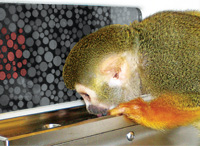 |
| In the computerized test of color blindness, monkeys receive
a drop of grape juice as a reward for getting the right answer.
Photo: Neitz Color Vision Lab |
The testing took more than a year and a half, and the researchers found that the monkeys were able to discern 11 intensities of 16 colors. “We’ve shown that we can cure a cone disease in a primate, and that it can be done very safely,” says Dr. Hauswirth. “That’s extremely encouraging for the development of therapies for human cone diseases that really are blinding.”
Mancuso K, Hauswirth WW, Li Q, et al. Gene therapy for red-green color blindness in adult primates. Nature. 2009 Sep 16; [e-pub ahead of print]

